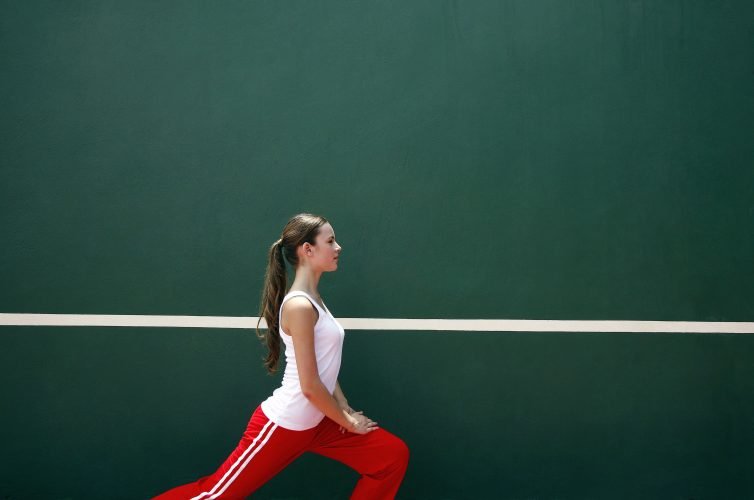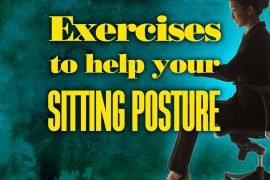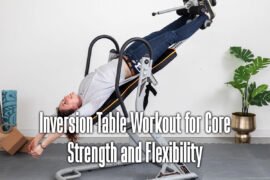In this article, you will see 6 simple exercises to improve posture are designed to build muscle, ease tension and give you a more statuesque posture. If you’d like a step-by-step guide that you can complete in 10 minutes, check out our exercise guide.
These exercises will focus on various parts of your body. Some will strengthen your core, others will improve your flexibility and others will return your spine and neck to the natural curves they should have. As always, consult with your doctor before beginning any new exercise regimen.
Let’s start by loosening your chest and hip muscles. Morgan Sutherland, an award-winning massage therapist with 14 years experience treating clients with chronic pain and sports injuries, suggests these 4 exercises.
6 Best Exercises To Improve Posture
Table of Contents
Doorway Stretch
This exercise loosens those tight chest muscles. Standing in a doorway, lift your arm so it’s parallel to the floor and bend at the elbow so your fingers point toward the ceiling. Place your hand on the door jamb. Slowly lean into your raised arm and push against the door jamb for 7-10 seconds.
Relax the pressure and then press your arm against the doorjamb again, this time coming into a slight lunge with your legs so your chest moves forward past the door jamb for 7-10 seconds. Repeat this stretch two to three times on each side.
- Increases flexibility in hips and thighs.
- Relieves lower back tension.
- Improves posture and spinal alignment.
- Easy to do with minimal equipment.
- It may be modified for different levels of flexibility.
- Improves flexibility in hamstrings and hip flexors
- It can alleviate lower back pain
- Easy to perform with no equipment needed
- Enhances mobility in daily activities
- It can reduce the risk of injury during physical activity
- It may exacerbate hip or lower back injuries
- It can cause discomfort or strain if done incorrectly
- It is not recommended for people with knee or ankle problems
Hip Flexor
Kneel on your right knee with toes down, and place your left foot flat on the floor in front of you. Place both hands on your left thigh and press your hips forward until you feel a good stretch in the hip flexors. Contract your abdominals and slightly tilt your pelvis back while keeping your chin parallel to the floor. Hold this pose for 20-30 seconds, and then switch sides.

Now that your core is loosened up, let’s work on straightening your stance.
- Strong hip flexors aid in athletic performance
- Tight hip flexors may cause lower back pain
- Hip flexor stretches can improve flexibility
- Hip flexor muscles are important for posture
- Sitting for long periods can weaken hip flexors
- Aids in maintaining good posture
- It helps with walking and running
- Improves athletic performance
- It helps to prevent lower back pain
- Facilitates daily movements such as bending and squatting
- It can become tight and lead to discomfort
- Overuse can lead to strain or injury
- Prolonged sitting can cause hip flexor tightness
Wall Angel
Stand with your back against a flat wall with your feet about four inches from the base. Maintain a slight bend in your knees. Your glutes, spine, and head should all be against the wall. Bring your arms up with elbows bent so your upper arms are parallel to the floor and squeeze your shoulder blades together, forming a letter “W”. Hold for 3 seconds.
Next, straighten your elbows to raise your arms up to form the letter “Y.” Make sure not to shrug your shoulders to your ears. Repeat this 10 times, starting at “W,” holding for 3 seconds and then raising your arms into a “Y.” Do 2-3 sets.

- Shoulder blade mobility exercise
- Improves posture
- Target upper back muscles
- Low-impact exercise
- It can be done anywhere with a wall
- Strengthens back and shoulder muscles
- Improves posture
- Stretches chest muscles
- It can be done anywhere with a wall
- Low impact exercise
- It may be challenging for beginners
- Requires good shoulder flexibility
- It may not provide a full-body workout
Chin Tuck
Here’s one you can do almost anywhere. The Chin Tuck can help reverse forward-head posture by strengthening the neck muscles. This exercise can be done sitting or standing. Start with your shoulders rolled back and down. While looking straight ahead, place two fingers on your chin, slightly tuck your chin and move your head back (image at left). Hold for 3-5 seconds and then release. Repeat 10 times.
Tip: The more of a double chin you create, the better the results. If you’re in a parked car, try doing the Chin Tuck pressing the back of your head into the headrest for 3-5 seconds. Do 15-20 repetitions.
Now that you are standing a little taller, let’s strengthen your core and legs. Our friends at WebMD have a couple great ideas.
- Improves posture and neck alignment
- Strengthens neck and upper back muscles
- Reduces strain on the cervical spine
- Enhances breathing and swallowing function
- It may alleviate headaches and neck pain
- Improves neck posture
- Relieves neck pain
- Reduces tension headaches
- Improves breathing and digestion
- Strengthens neck muscles
- It can be uncomfortable for some
- May exacerbate certain spinal conditions
- Not recommended for individuals with certain medical conditions
Leg Extension
Lie on your back with your knees bent, feet flat on the floor, and hands behind your head. Press your low back into the floor, and curl your head up off the floor. Exhale strongly and pull your navel in and up toward your spine. Slowly pull one knee into your chest, keeping your low back pressed to the floor while extending your other leg straight at about a 45-degree angle off the floor.
Keep your abdominals pulled in and your low back on the floor. If your low back arches off the floor, extend your leg higher toward the ceiling. Switch legs. Start with five to 10 extensions on each side.

Why It’s Good for You: This move trains your core muscles to work together to stabilize your pelvis.
- Targets quadriceps muscles
- Low impact exercise
- Adjustable seat and backrest
- Isolates leg muscles
- It helps improve knee extension strength
- Improves knee joint stability
- Isolates quadriceps muscles for targeted training
- Low risk of injury compared to compound exercises
- It can be used to correct muscle imbalances
- Can be done with minimal equipment
- Places excessive stress on the knee joint
- Limited functional carryover to daily activities or sports
- Doesn’t engage other muscle groups for overall strength
Crunches
Lie on your back with your knees bent, feet flat on the floor. Press your low back into the floor. Place your hands behind your head, or reach your arms toward your knees if it doesn’t create too much tension in your neck. Exhale strongly and pull your navel in and up toward your spine. Curl your head and shoulders slowly off the floor. Hold, then slowly lower back down. Repeat three times.
Why It’s Good for You: Also called a “curl-up,” this exercise works the rectus abdominis (the six-pack muscle) and obliques (which run diagonally around your waist and rotate your torso).
- Abdominal muscle activation
- Minimal equipment needed
- It can be modified for all fitness levels
- Helps improve posture
- Targets specific areas of the core
- Builds core strength
- Targets abdominal muscles
- Can be done without equipment
- Improves posture
- It can be modified for different skill levels
- It can strain the neck and back
- It may not burn many calories
- Overuse can lead to muscle imbalances
Benefits of the Exercises To Improve Posture
Improving posture through exercises can provide several benefits, including:
- Reduced pain: Poor posture can cause pain in the neck, back, and shoulders. By improving your posture, you can reduce these types of pain.
- Improved balance: Good posture improves your balance and stability, which can reduce the risk of falls and injuries.
- Increased energy: When you have good posture, your body does not have to work hard to maintain proper alignment, which can help you feel more energetic throughout the day.
- Better breathing: Good posture allows your lungs to expand fully, which can help you breathe more deeply and efficiently.
- Improved digestion: Poor posture can compress your organs and makes it harder for your body to digest food. Good posture can help your organs function properly, leading to better digestion.
- Enhanced self-confidence: Good posture can make you appear more confident and assertive, which can have a positive impact on your mood and social interactions.
- Reduced stress: Poor posture can put unnecessary stress on your muscles and joints. You can reduce stress and feel more relaxed and comfortable by improving your posture.
Overall, improving your posture through exercise can have a significant positive impact on your health and well-being.
Things To Avoid While Doing The Exercises To Improve Posture
When doing exercises to improve posture, it’s important to avoid certain things to prevent injury and maximize the benefits of the exercises. Here are some things to avoid:
- Over-exerting yourself: Start slow and build up gradually. Overexertion can lead to muscle strain and injury.
- Poor form: Make sure you are doing the exercises with the correct form to avoid injury and maximize the benefits. If you’re not sure, consult a fitness professional.
- Holding your breath: Breathe deeply and regularly while doing the exercises. Holding your breath can increase blood pressure and strain the muscles.
- Using weights that are too heavy: Use weights that are appropriate for your fitness level. Using weights that are too heavy can increase the risk of injury.
- Ignoring pain: If you experience pain during an exercise, stop immediately. Pain is a sign that something is very wrong, and continuing to exercise can make the problem worse.
- Doing the same exercises every day: Mix up your exercises to avoid overuse injuries and to work for different muscle groups.
- Neglecting to warm up and cool down: Warm up with some light cardio and dynamic stretching before starting your exercises. Cool down with static stretching and some gentle movement after your workout to help prevent muscle soreness and stiffness.
FAQs
Q1. Why is good posture important?
Good posture helps prevent back pain, improves breathing and circulation, and enhances confidence and appearance.
Q2. What are some common causes of poor posture?
Poor posture can result from factors such as sitting for prolonged periods, using electronic devices, carrying heavy bags or backpacks, and wearing high heels.
Q3. What are some exercises to improve posture?
Some exercises to improve posture include shoulder blade squeezes, chin tucks, wall angels, seated spinal twists, plank variations, and bridges.
Q4. How often should I do posture exercises?
It is recommended to do posture exercises at least 2-3 times a week to see improvements.
Q5. How much time it takes to see results from posture exercises?
Results may vary, but consistent practice can lead to noticeable improvements within a few weeks to a few months.
Q6. Can posture exercises be done at home?
Yes, posture exercises can be easily done at home with little to no equipment.
Q7. Are there any risks associated with posture exercises?
As with any exercise program, it is essential to consult with your healthcare professional before starting. Improper form or overexertion can lead to injury.
Conclusion
These are just the start. Check out the links provided for more exercises you can add to your daily routine which will strengthen your core, give you flexibility and the energy you need to take on your day. But, remember that technique matters as much as repetition. Study the proper forms to get the most benefit. And listen to what your doctor (and your body) tells you. Here are some things to remember when you are exercising:
- Remember to exhale forcefully and tighten your core muscles as you perform these exercises to help gain the most benefit.
- Pull your abdominal muscles in and up toward your spine as you exercise.
- Work with slow, controlled movements, breathing evenly, without holding your breath.
- Tailor your number of repetitions and sets to your current level of core fitness.
- If you have mild back pain, core-strengthening exercises may improve posture, ease symptoms, and prevent future pain. If you have severe back pain or injury, are out of shape, or have any medical problems, talk to your doctor before you start any exercise program. Some exercises may not be recommended.
- Stop doing any activity that causes pain or makes pain worse.









1 Comment
Thank you so much for sharing this. I needed this read as people kept telling me that I always crouch even when I think I am not. Keep it up! I will share this with others as well.